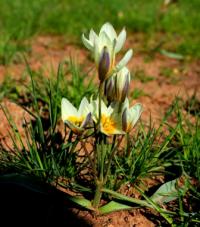Вы здесь
Tulipa binutans.

Beautiful nature in Kazakhstan and Central Asia.
“It is untrue that equality is a law of nature. Nature has no equality; its sovereign law is subordination and dependence”
Luc de Clapiers de Vauvenargues.
Botanical Holidays in Kazakhstan.
Tulipa binutans Vved. 5 - 25 cm long, bulb ovoid, 15 - 20 mm in diameter, skinned tunic chaffs, reddish-brown, later grey-brown, arachnoid-woolly inside, denser at the top of scales.
Upper part of stem is brachigerous, with friable pubescent peduncle. Leaves 2, straddled, deflexed, liner, glaucous, glabrate, loose-ciliated, the lower one is 10 - 15 mm broad, slightly exceeding the stem.
Flowers 2 - 3 in number (5), in buds drooping. Petals are 15 - 25 mm long, white, yellow at the base and long-cetoues inside, bearded, acute, dingy-reddish-violet on the outside, oblong- lanceolate, the outer are 1,5 times narrower than oblong inner ones.
Stamen filaments are yellow, extended over the base, with hairy ring in the extended part and hairy upwards, anthers are linear-oblong, yellow. Fruit case is oblong, young are drooping, old are erect. Flowering time at the end of March – April.
Distribution in Kazakhstan: endemic. It grows on rocky and fine-earth slopes of mountain ribs, extends to the east of Karatau Range, and sometimes to the north of Kirghiz Alatau on sandy soils in Muyunkum and to clay deserts of Prebalkhash.
Authority
“Tulips of Kazakhstan”. Almaty, LTD “Almatykitap baspasy”. 2010, 272 p. Illustrated.
Photos by
Alexander Petrov.







